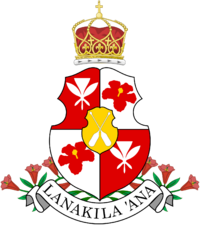Coat of arms of Konalani
| Royal coat of arms of Konalani | |
|---|---|
 | |
| Armiger | Queen Lokelani in right of the Crown |
| Adopted | December 20, 1835 |
| Crest | Upon the helm, the Crown of Konalani |
| Blazon | Quarterly, I and IV Gules, a kāhili argent. II and III Agent, a hibiscus Gules, stem Or. Inescutcheon Or, crossed oars Argent. |
| Compartment | Hibiscus rosa-sanbensis |
| Motto | Konalanese: Lanakila ʻana (“To victory”) |
The royal coat of arms of Konalani (Konalanese: ʻAʻahu aliʻi o Konalani; Oharic: Yekonalanī Nigushawī K'emīsi) is the national coat of arms of the Kingdom of Konalani. Adopted in 1835 during the reign of ʻIolani II, the coat of arms features a shield divided into four quarters, alternating between a white kāhili on a red field, and a red hibiscus on a white field, with two crossed oars on a gold field in a inescutcheon in the centre of the coat of arms. The Crown of Konalani makes up the crest above the shield, while a scroll reading Konalani's national motto, Lanakila ʻana (Anglish: "To victory"), is positioned below the shield.
Symbolism
The divisions in Konalani's coat of arms represent the three main islands of the archipelago. The white kāhili, a symbol of Native Konalanese authority and nobility, on a red field represents Mokunui, the red hibiscus on a white field represents Ainapua, and the crossed oars on a gold field represent Nahoe. The crown above the shield represents the Konalanese monarchy, based off the design off the 1848 coronation crown of ʻIolani II. Below the shield is a compartment of Hibiscus rosa-sanbensis, a common flower on the islands. The motto Lanakila ʻana (Anglish: "To victory") is said by unofficial tradition to have been used during ʻIolani I's conquest of the Konalanese archipelago, but this claim is unsubstantiated by official accounts of the period.
History
The first coat of arms designed for a Konalanese monarch was for ʻIolani I in 1822, after the signing of the Treaty of the Paddles recognizing Konalani's sovereignty. With the need to adopt a western-style symbol for the new realm, ʻIolani I adopted a coat of arms featured two crossed paddles on a gold field to represent the Konalanese state in diplomatic functions. This coat of arms was retired by ʻIolani II upon his ascension in 1835, as the crossed oars were considered the personal symbol of ʻIolani I and his reign. As its replacement, ʻIolani II adopted the current coat of arms as with pan-insular imagery, as the crossed oars became associated specifically with the island of Nahoe, the origin of the House of ʻIolani. Since 1835, the coat of arms have remained unmodified with the addition of the Konalanese crown in the mid-19th century, and have continuously represented Konalani as a state and monarchy for over 150 years.
